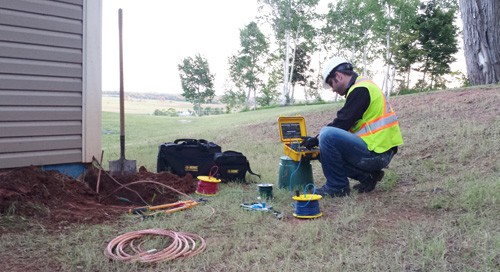
Concealed Installations:
New constructions have the unique opportunity of installing fully concealed systems. This type of concealed lightning protection, installed during construction and before insulation, features all cables running inside the structure. The only thing visible is the lightning rods themselves!
Exterior Installations:
Our exterior installations are done in a discreet and tidy manner, running cables down corners, behind downspouts or inside corner casings and along the roof ridge. Copper or tin coated cable can be chosen based on the aesthetic of the home and the preference of the client. Aluminum cable is also available for steel roofs!
Following the installation of your lightning protection system, Maritime Lightning Protection will present you with a certification document. This certification guarantees the installation meets all code and safety requirements outlined by the CSA B72-20 for lightning protection systems. Certification sets standards on the system design, the material used and installation guidelines.
Maritime Lightning Protection offers certification on all new or existing installations.
Maritime Lightning Protection is qualified to provide a formal Lightning Damage Risk Assessment based on industry standards as outlined in the CSA B72-20 and NFPA 780. These technical Risk Assessments have been developed and refined to provide a mathematically-based evaluation and recommendation based on project-specific factors as to whether a structure SHOULD have lightning protection installed or if, by code, installation of a system is OPTIONAL.
The following factors are evaluated:
The assessment quantifies two factors: the lightning threat evaluation and the tolerable lightning frequency. The lightning threat evaluation determines the average lightning strike frequency for the structure using:
The tolerable lightning frequency determines the risk tolerance for the structure using:
Once the assessment is complete, a formal report is provided containing an appendix with the risk assessment calculation completed with associated variables. If your project requires a risk assessment to be certified by an engineer, we can also arrange for that!
Contact us today if you want a risk assessment for your current or future property!
The initial step in any certified lighting protection system is the design. Upon receipt of structural drawings, blueprints or AUTOCAD files, Maritime Lightning Protection can prepare detailed specifications covering any size building or project. We can prepare drawings and specifications including everything necessary to provide a complete lightning protection system to meet the requirements of the Canadian Standards Association (CSA B72-20) Installation code for lightning protection systems.
We also design systems which meet other international lightning protection codes such as: Underwriters Laboratories (UL 96A), National Fire Protection Association (NFPA 780) and the Lightning Protection Institute (LPI 175).
Most lightning protection systems are designed to last the life of the structure and require minimal maintence. However, to ensure that your lightning protection system is fully functional and complies with latest standards and code requirements, Maritime Lighting Protection recommends routine inspections be completed by a licensed lightning protection contractor.
Upon completing an on-site inspection of the lightning protection system, Maritime Lightning Protection will provide the client with a detailed written report of the findings from this inspection. If alterations, repairs or additions are required to the system, to comply with the National Code, these will be noted in the report along with a free estimate to complete this work.
The frequency of the inspection is based upon the type of installation.
While this a basic guideline, any modifications made to your structure; such as roof renovations, an addition or renovation to the structure, the installation of roof top equipment such as HVAC units, ventilators, and satellite dish will require alterations to the lighting protection. An inspection of the lightning protection system should be completed by a licensed contractor to determine what effect these modifications have had on the system and what alterations would be required to the lightning protection system.

One of the vital parts of any lightning protection system or electrical system is the grounding. Proper grounding reduces the risk of damage. The grounding, which is made up of ground electrodes, is what discharges the energy safely into the ground. When a lightning protection system has been designed and installed, it is required to measure and confirm the earth resistance between the ground electrodes and soil. Testing the ground resistance for a structure’s lightning protection and grounding system will confirm the ability to dissipate lightning strikes and electrical surges created by lightning.
Maritime Lightning Protection is trained to perform 3-Point, 4-Point Fall of Potential Tests and also has the training and capability to perform earth coupling measurement, soil resistivity and bonding tests. Maritime Lightning Protection utilizes quality test equipment that is calibrated on annual basis to ensure accurate readings.